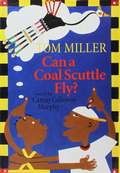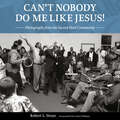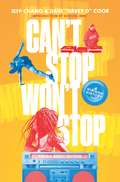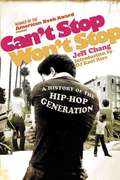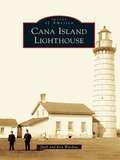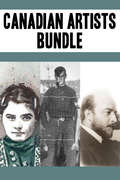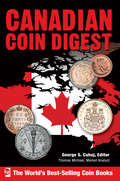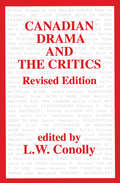- Table View
- List View
Can I Recycle This?: A Guide to Better Recycling and How to Reduce Single-Use Plastics
by Jennie Romer&“If you&’ve ever been perplexed by the byzantine rules of recycling, you&’re not alone…you&’ll want to read Can I Recycle This?... An extensive look at what you can and cannot chuck into your blue bin.&” —The Washington PostThe first illustrated guidebook that answers the age-old question: Can I Recycle This?Since the dawn of the recycling system, men and women the world over have stood by their bins, holding an everyday object, wondering, "can I recycle this?" This simple question reaches into our concern for the environment, the care we take to keep our homes and our communities clean, and how we interact with our local government. Recycling rules seem to differ in every municipality, with exceptions and caveats at every turn, leaving the average American scratching her head at the simple act of throwing something away. Taking readers on a quick but informative tour of how recycling actually works (setting aside the propaganda we were all taught as kids), Can I Recycle This gives straightforward answers to whether dozens of common household objects can or cannot be recycled, as well as the information you need to make that decision for anything else you encounter. Jennie Romer has been working for years to help cities and states across America better deal with the waste we produce, helping draft meaningful legislation to help communities better process their waste and produce less of it in the first place. She has distilled her years of experience into this non-judgmental, easy-to-use guide that will change the way you think about what you throw away and how you do it.
Can Pop Culture and Shakespeare Exist in the Same Classroom?: Using Student Interest to Bring Complex Texts to Life
by Kristine Gritter Kathryn Schoon-Tanis Matthew AlthoffExpecting students to jump right into a rigorous literature discussion is not always realistic. Students need scaffolding so that they will be more engaged and motivated to read the text and think about it on a deeper level. This book shows English language arts teachers a very effective way to scaffold—by tapping into students’ interest in pop culture. You’ll learn how to use your students’ ability to analyze pop culture and transfer that into helping them analyze and connect to a text. Special Features: Tools you can use immediately, such as discussion prompts, rubrics, and planning sheets Examples of real student literature discussions using pop culture Reflection questions to help you apply the book’s ideas to your own classroom Connections to the Common Core State Standards for reading, speaking, and listening Throughout the book, you’ll discover practical ways that pop culture and classic texts can indeed coexist in your classroom. As your students bridge their academic and social lives, they’ll become more insightful about great literature--and the world around them.
Can Pup Find the Pups? (I Like to Read)
by Vincent X KirschPup can&’t find the 5 pups. Can you? This Level F reader is perfect for final term kindergarteners, first term first graders, and summer time fun!Tate looks for new things to draw.Pup looks too.Tate sees new things to draw.Pup sees five pups.The pups are hiding in the museum. There they are--among the dinosaurs, planets and even the butterflies! Children will enjoy practicing their reading skills as they search the pictures for fun details and five mischievous puppies.This book has been tested by the official Fountas and Pinnel leveling system. You will also like Can You Find Pup?, another I Like to Read® book by Vincent X. Kirsch.Level F books, for early first graders, feature longer, more varied sentences than Level E. Level F books encourage kids to decode new multi-syllable words in addition to recognizing sight words. Stories are more complex, and illustrations provide support and additional detail. When Level F is mastered, follow up with Level G.The award-winning I Like to Read® series focuses on guided reading levels A through G, based upon Fountas and Pinnell standards. Acclaimed author-illustrators--including winners of Caldecott, Theodor Seuss Geisel, and Coretta Scott King honors—create original, high-quality illustrations that support comprehension of simple text and are fun for kids to read again and again with their parents, teachers or on their own!
Can You Become a Pop Star?: An Interactive Adventure (You Choose: Chasing Fame and Fortune)
by Allison LassieurDo you dream of belting out a chart-topping single on stage in front of thousands of people? Even with talent and determination, it’s a long, winding journey to the top. Chart your path to stardom, facing real-life choices as you go. Some choices may lead to center stage, while others lead to disappointment or redirection into another career field.
Can You Escape a Haunted Castle? (You Choose)
by Ailynn CollinsYour steps echo down the long hall of an old stone castle. The candles and old tapestries make it easy to imagine you’re living hundreds of years ago. So does the knight’s armor in the corner. Wait—did it just move? Choose your own path as you explore the world’s most haunted castles. Will you escape or be frozen in fear? Find out in these pages!
Can You Escape a Haunted Hotel? (You Choose)
by Megan Cooley PetersonThe lights flicker in your hotel room. The phone rings, but there’s no one there. The temperature drops suddenly. Is that a draft from the storm outside, or is it the chill of a ghostly presence? Choose your own path as you explore the world’s most haunted hotels. Will you check out safely or be overwhelmed with fear? Find out in these pages!
Can You Find Pup? (I Like to Read)
by Vincent X KirschIn this easy-to-read, search-and-find story, Tate draws cats, bugs, and birds--but he never draws Pup!Tate likes to draw. He draws 10 cats on the couch, 10 bugs in the garden, and 10 birds in the park. Pup, who craves attention, is never in Tate's pictures. Pup is very upset, so he runs away to join the circus. Tate misses Pup and draws many, many pictures of the dog to hang all over town. Tate and Pup reunite, and now Tate will always remember to draw Pup.While reading the story, readers can search for cats, bugs, birds, and Pup.A Junior Library Guild selection!
Can You Top This?
by Senator Ed Ford Harry Hirschfield Joe Laurie Jr.You know this trio of gagsters. They’re heard twice weekly, over the NBC national hookup on Fridays, and over station WOR every Wednesday night.Here, sifted from thousands of their best, is the very cream of their jets. Most of these stories broke the Laughmeter as studio audiences howled with delight. Even if you’ve heard some of them before, you’ll love the new twist these experts have given them.Just to add to the general hilarity of the book, thumbnose sketches of each other have been written by those versatile gentlemen, and a further attraction, they have thrown in cartoons too.One word of warning before you open CAN YOU TOP THIS? Don’t blame us if you laugh yourself sick.
Can Your Outfit Change the World? (PopActivism)
by Erinne PaisleyWhat you choose to wear becomes part of your identity, but it doesn't affect just you. Your clothing sends a message to the world, whether you want it to or not! And often we don't know what that message really is. Can Your Outfit Change the World? looks at how and where clothes are made, how the people who make the clothes are treated and how the companies who sell the clothes affect the health of our planet. Armed with information, you can follow the book's guide to spending your fashion dollars in a responsible and eco-friendly way. Your outfits have more power than you might realize!
Can Your Smartphone Change the World? (PopActivism #1)
by Erinne PaisleyCan Your Smartphone Change the World? is a twenty-first-century guide for anyone who has access to a smartphone. This how-to manual looks at specific ways you can create social change through the tap of a screen. Filled with examples of successful hashtag campaigns, viral videos and new socially conscious apps, the book provides practical advice for using your smartphone as a tool for social justice. This is the first book in the PopActivism series. Can Your Outfit Change the World? comes out in spring 2018 and Can Your Conversations Change the World? in fall 2018.
Can a Coal Scuttle Fly
by Tom Miller Camay Calloway MurphyTom Miller tells us about his journey to becoming an artist.
Can't Nobody Do Me Like Jesus!: Photographs from the Sacred Steel Community
by Robert L. StoneFolklorist Robert L. Stone presents a rare collection of high-quality documentary photos of the sacred steel guitar musical tradition and the community that supports it. The introductory text and extended photo captions in Can’t Nobody Do Me Like Jesus! Photographs from the Sacred Steel Community offer the reader an intimate view of this unique tradition of passionately played music that is beloved among fans of American roots music and admired by folklorists, ethnomusicologists, and other scholars. In 1992, a friend in Hollywood, Florida, introduced Stone to African American musicians who played the electric steel guitar in the African American Holiness-Pentecostal churches House of God and Church of the Living God. With the passion, skill, and unique voice they brought to the instruments, these musicians profoundly impressed Stone. He produced an album for the Florida Folklife Program, which Arhoolie Records licensed and released worldwide. It created a roots music sensation. In 1996, Stone began to document the tradition beyond Florida. He took the photos in this book from 1992 to 2008 in Georgia, the Carolinas, Tennessee, Mississippi, New York, Pennsylvania, Michigan, and Florida, and at concerts in Italy. The images capture musicians as they play for worship services before spirit-filled believers singing, dancing, shouting, praying, and testifying. Stone gives the viewer much to witness, always presenting his passionate subjects with dignity. His sensitive portrayal of this community attests to the ongoing importance of musical traditions in African American life and worship.
Can't Stand Up For Sitting Down
by Jo BrandThe Stand-Up while Sitting Down Years...Jo Brand is one of our best-loved comedians, according to a quote she made up. This memoir is full of hard-won wisdom, hilarity and her views on life, laughs, friendships and all the good and bad things in the world. If she was Prime Minister, the country would be in even more of a mess than it is.
Can't Stand Up For Sitting Down
by Jo BrandThe Stand-Up while Sitting Down Years...Jo Brand tells the story of how she crawled to fame and fortune, managed to persuade someone to marry her and had some children at an age when she should have been in a bath chair on the seafront. In this second volume of her memoirs, Jo recounts wild times on the comedy circuit, the attempts to tart her up for the TV screen, running the marathon, rally driving, her numerous, occasionally extremely inebriated, Edinburgh festival appearances, her 'acting' career, and much, much more.Jo Brand is one of our best-loved comedians, according to a quote she made up. This memoir is full of hard-won wisdom, hilarity and her views on life, laughs, friendships and all the good and bad things in the world. If she was Prime Minister, the country would be in even more of a mess than it is.(P)2010 Headline Digital
Can't Stop Won't Stop (Young Adult Edition): A Hip-Hop History
by Jeff Chang Dave CookThe American Book Award winner, now completely adapted for a young adult audience! From award-winning author Jeff Chang, Can't Stop Won't Stop is the story of hip-hop, a generation-defining movement and the music that transformed American politics and culture forever. Hip hop is one of the most dominant and influential cultures in America, giving new voice to the younger generation. It defines a generation's worldview. Exploring hip hop's beginnings up to the present day, Jeff Chang and Dave "Davey D" Cook provide a provocative look into the new world that the hip hop generation has created. Based on original interviews with DJs, b-boys, rappers, activists, and gang members, with unforgettable portraits of many of hip hop's forebears, founders, mavericks, and present day icons, this book chronicles the epic events, ideas and the music that marked the hip hop generation's rise.
Can't Stop Won't Stop: A History Of The Hip-hop Generation
by Jeff Chang D. J. Kool HercForged in the fires of the Bronx and Kingston, Jamaica, hip-hop has been a generation-defining global movement. In a post-civil rights era rapidly transformed by deindustrialization and globalization, hip-hop gave voiceless youths a chance to address these seismic changes, and became a job-making engine and the Esperanto of youth rebellion. Hip-hop crystallized a multiracial generation's worldview, and forever transformed politics and culture. But the epic story of how that happened has never been fully told . . . until now. Jeff Chang has been a hip-hop journalist for more than a decade and has written for The San Francisco Bay Guardian,The Village Voice,Vibe,The Nation,URB,Rap Pages,Spin, and Mother Jones. He was a founding editor of Colorlines Magazine, senior editor at Russell Simmons's www.360hiphop.com, and co-founder of the influential hip-hop label SoleSides, now Quannum Projects.
Cana Island Lighthouse (Images of America)
by Barb Wardius Ken WardiusThe Cana Island Lighthouse is one of the most picturesque of any lighthouses still operating on the Great Lakes today. The beautiful peninsula of Door County has a long and bountiful tradition of maritime history, including its many lighthouses. Cana Island has illuminated the coastline on the Lake Michigan side of Door County for over 100 years. Cana Island's story involves bricks and mortar, engineering marvels, and, most noteworthy, people. The dedication of Cana's keepers and their families over the years was remarkable. Countless mariners relied on them. Lighthouse life could be challenging, at times tedious, but also extremely rewarding. Most visitors will agree that Cana Island is indeed an extraordinary place.
Canadian Art in the Twentieth Century
by Joan MurrayCanadian Art in the Twentieth Century is a survey of the richest, most controversial and perhaps most thoroughly confusing centuries in the whole history of the visual arts in Canada - the period from 1900 to the present. Murray shows how, beginning with Tonalism at the start of the century, new directions in art emerged - starting with our early Modernists, among them Tom Thomson and the Group of Seven. Today, Modernism has lost its dominance. Artists, critics, and the public alike are confronted by a scene of unprecedented variety and complexity. Murray discusses the social and political events of the century in combination with the cultural context; movements, ideas, attitudes, and styles; the important groups in Canadian art, and major and minor artists and their works. Fully documented, well researched and written with clarity and over four hundred illustrations in both black-and-white and colour, Murray’s book is essential for understanding Canadian art of this century. As an introduction, it is excellent in both its scope and intelligence.
Canadian Artists Bundle: Emily Carr / Tom Thomson / James Wilson Morrice
by Wayne Larsen Kate BraidPresenting three titles in the Quest Biography series that profiles prominent figures in Canada’s history. Canada’s vast wilderness presents many opportunities for artists to capture its beauty in their distinct styles, and the country has produced its share of talented landscape painters. Tom Thomson’s work is known the world over for its wild, vivid portrayals of Ontario’s wilderness. Emily Carr captured the lushness of the west coast as well as the traditional culture of the indigenous peoples. Lesser known, James Wilson Morrice also contributed to Canada’s landscape painting legacy through paintings inspired by such artists as the Impressionists and Van Gogh. These artists’ lives are as fascinating as their work. Includes Emily Carr Tom Thomson James Wilson Morrice
Canadian Cinema Since the 1980s
by David L. PikeAward-winning author David L. Pike offers a unique focus on the crucial quarter-century in Canadian filmmaking when the industry became a viable force on the international stage. Pike provides a lively, personal, and accessible history of the most influential filmmakers and movements of both Anglo-Canadian and Quebecois cinema, from popular movies to art film and everything in between.Along with in-depth studies of key directors, including David Cronenberg, Patricia Rozema and Denys Arcand, Jean-Claude Lauzon, Robert Lepage, Léa Pool, Atom Egoyan, and Guy Maddin, Canadian Cinema since the 1980s reflects on major themes and genres and explores the regional and cultural diversity of the period. Pike positions Canadian filmmaking at the frontlines of a profound cinematic transformation in the age of global media and presents fresh perspectives on both its local and international contexts. Making a significant advance in the study of the film industry of the period, Canadian Cinema since the 1980s is also an ideal text for students, researchers, and Canadian film enthusiasts.
Canadian Coin Digest
by George S. CuhajCoins of Canada From the earliest unified coinage in 1858 to the latest releases from the Royal Canadian Mint, Canadian Coin Digest has it all. The trusted numismatic editors and market analysts of the Krause Publications' Standard Catalog division have compiled an extensive, accurate, up-to-date listing of Canadian coinage. This new edition features: Over 1,200 images Thousands of accurate price listings New issues from the Royal Canadian Mint Accurate mintage figures KM identification numbers Detailed descriptions Trust the experts at Krause Publications to bring you a complete, economical, accurate guide to Canadian coins.
Canadian Coin Digest
by George S. Cuhaj Thomas MichaelCoins of Canada Featuring more than 150 years of coins, pricing in up to six grades, and the authoritative voice of the most trusted name in numismatics, the second edition of Canadian Coin Digest offers a grand overview of the coins of Canada while providing the greatest value of any guide on the market. Canadian Coin Digest features: More than 1,200 images Tens of thousands of accurate price listings New issues from the Royal Canadian Mint Accurate mintage figures KM identification numbers Detailed descriptions Count on the numismatic experts at Krause Publications to bring you a complete, economical, and accurate guide to Canadian coins.
Canadian Cultural Policy in Transition (Routledge Studies in Media and Cultural Industries)
by Devin BeauregardThis book offers a comprehensive overview of Canadian cultural policy and research, at a time of transition and redefinition, to establish a dialogue between conventional and emerging foundations. Taking a historical view, the book informs insights on current trends in policy and explores global debates underpinning cultural policy studies within a local context. The book first acknowledges what Canadian cultural policy research conventionally recognizes and refers to in terms of institutions, values, and debates, before moving on to take stock of the transformations that are continuing to reshape Canadian cultural policy in terms of values, orientations, actors, and institutions. With a focus on all levels of government-- federal, provincial, and local -- the book also centers on Indigenous arts policies and practices. This systematic and inclusive volume will appeal to academic researchers, graduate students, managers of arts and culture programs and institutions, and in the areas of cultural policy, public administration, political science, cultural studies, film and media studies, theatre and performance, and museum studies.
Canadian Drama and the Critics
by L. W. ConollyThe editor of this lively, updated assortment of reviews, interviews and other critical deliberations on contemporary Canadian drama has gathered material from books, theatre and scholarly journals; from major daily newspapers in Canada and abroad; from critics, academics, journalists and playwrights. This new expanded and updated edition of Canadian Drama and the Critics now includes commentary on forty-three English-language plays written during the last fifty years. | |Canadian Drama and the Critics is an enjoyable read that offers an intelligent, wide-ranging overview of modern Canadian plays and playwrights. An ideal companion text to Talonbooks' Modern Canadian Plays Volumes I and II and other anthologies of Canadian drama, Canadian Drama and the Critics also includes detailed production information for the premiere of each play and a comprehensive index.
Canadian Modern Architecture: A Fifty Year Retrospective (1967-2017)
by Elsa Lam Graham LiveseyCanada's most distinguished architectural critics and scholars offer fresh insights into the country's unique modern and contemporary architecture. Beginning with the nation's centennial and Expo 67 in Montreal, this fifty-year retrospective covers the defining of national institutions and movements, how Canadian architects interpreted major external trends, regional and indigenous architectural tendencies, and the influence of architects in Canada's three largest cities — Toronto, Montreal, and Vancouver. Co-published with Canadian Architect, this comprehensive reference book is extensively illustrated and includes fifteen specially commissioned essays.










